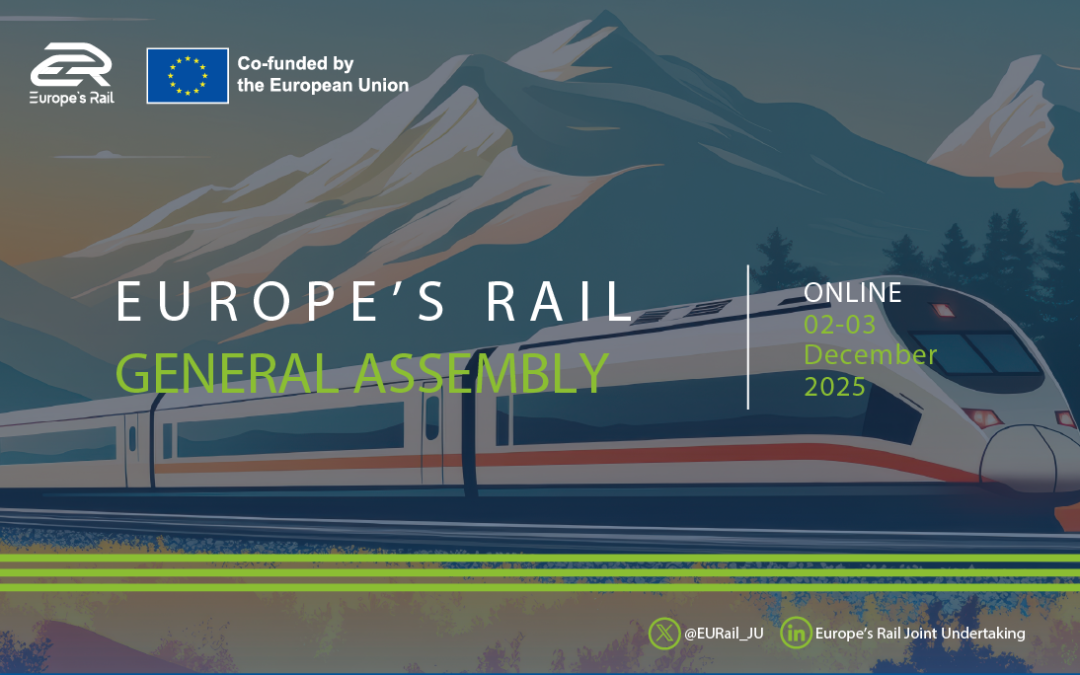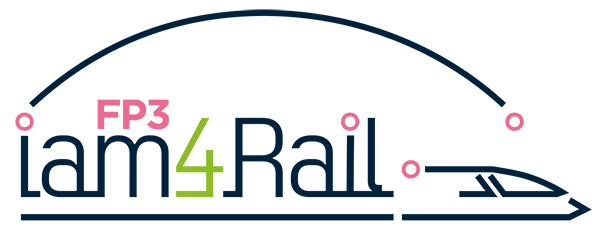On 2–3 December, the Europe's Rail General Assembly 2025 took place, providing a valuable occasion to look back at the...


Currently available work packages:
The Objective of WP3 is to design the generic architecture and to implement field installations for the setup of an Intelligent Asset Management System (IAMS) paving the way for the development of analytics and the integration with the TMS that WP4 will carry out.
WP4 will focus on the fine-tuning of the data collection processes, on the design refinement, development, and integration of analytics methodologies, and on the integrated demonstration at TRL 6/7 of the Use Cases (UC) defined in WP3 in line with the specific UC requirements and the guidelines of WP2. The objectives are to collect, process and analyse Diagnostic & Operation data coming from different railway systems to provide nowcasting and forecasting capabilities on the status of the monitored assets.
To define predictive and prescriptive functionalities with regards to asset status determination and intelligent maintenance thanks to WP3 data that will be fed to the analytics and to develop a Decision Support System (DSS).
The objective of WP5, addressing Rolling Stock, is to provide and develop technologies for on-board inspection and monitoring of Rolling Stock sub-systems and components, applicable for several line types. Relying on previous European projects such as PIVOT2 (GA ID: 881807) or PINTA2 (GA ID: 826054) where appropriate technologies for some assets like bogie and traction components, esp. for journal bearing and wheel monitoring, have already been successfully developed, WP5 will focus on those technologies that do not yet have reached necessary maturity level and to extend the monitoring range / application of existing technologies to further components by definition of physical parameters for anomaly detection.. Overall WP5 will provide technological foundations to fully leverage the value of data for rolling-stock asset management in WP6.
The objective of WP6, addressing Rolling Stock operating on different types of lines and under different climate conditions, is to design, develop, validate, and deploy at TRL 6/7 CBM (condition-based maintenance) based on ML (machine learning), predictive algorithms and digital process aids capable of supporting the railway maintainers, owners, and operators in the decision-making process. Even though, the focus of this WP will be on passenger trains, there will be a strong link with WP7 which also includes the monitoring of Freight.
This WP7 considers the integration of previous achievements in the railway sector on wayside monitoring, but also the development of new solutions applied for lines with cross-border and mixed traffic to create a more complete European Railway Checkpoint, including the required inputs for their basic specifications. The main objective is to provide and develop technologies for the installation of European Railway Checkpoints being control points in relevant sections of the TEN-T along the railway network with multiple arrays of sensing.
WP9 develops asset management solutions for the track structure, including plain track, switches, and crossings (S&C), catenary, and other elements of the track structure. Particularly, WP9 develops innovative wayside, onboard and crowd-based sensing solutions for the timely extraction of track infrastructure data. The data is converted into information/ knowledge using AI- and physics-based methodologies for anomaly detection and failure prediction. Then, the solutions are embedded into digital tools to support decision-making from existing and improved asset management platforms for track structure to reduce costs and increase safety, while considering constraints given by nowadays requirements on sustainability, resilience, trustworthy digitalization, and ethics.
The objective of this work package is to bring asset management solutions devised in the context of previous EU projects including those in Shift2Rail JU (i.e. IN2SMART and IN2SMART2) not mature enough at the next level of its application, and above all, explore and deploy the innovative solutions for the rail infrastructure subsystem in an operational environment with the focus on “short-term asset management” and off-site work preparation to be integrated as a multi-source/multi-purpose (MSMP) asset management platform. To fulfil this objective the focus is to provide – and apply – traceable diagnostic and prognostic information in a continuous manner based on embedded wayside and onboard sensors to support day-by-day decisions by maintenance experts and asset managers.
The objective of this work package is to conduct the main body of development for work in tasks including the demonstration of the applications conceptualized and started in WP 10 for the multi-source/multi-purpose (MSMP) asset management platform. The scientific development focuses on data analytics to utilize numerous waysides and train borne sensors including new sensor concepts and configurations. The necessary data sets are gathered in operational environment utilizing wayside and train-borne sensor systems in diverse EU member states such as Spain and the Netherlands operational environments and climate types providing the base for a successful cross-border and interoperable demonstration. at The detailed objectives of this work package are aligned with WP10.
This work package (in coordination with WP13) aims to enhance the whole life-cycle management of civils, addressing various assets and systems including railway civil structures such as tunnels and bridges; civil works including earthworks and their environment; vegetation, landslides, floods, and other external factors from various sources influencing railway infrastructures.
WP13 is dedicated to the development and implementation of the technological demonstrator based on the outcome of the activities performed in WP12. The overall ambition of the WP is to create a working environment at different planning levels (strategic, tactical, and operational) where information coming from various sources of data are jointly exploited to provide maintenance decision-support.
The development of a robotics platform and of it related tools (e.g., a certification framework) is one of the priorities for the railway industry. It gives birth to a new generation of cross-border tooling. For many reasons, railway robots must be developed in modular form (composed of standard building blocks selected according to the need). Therefore, a platform, and even more so an open-source platform, is the best strategy for implementation. Standard existing technical tools to support this strategy are analysed. Some are selected and adapted for railway applications.
The aim of this WP is the development of novel and smart assistive tools to support workers in their daily railway maintenance tasks. More specifically, technology is developed to improve human safety and skills in workplace through Exoskeleton and Augmented Reality systems. Real use case specifications must be gathered, and improved systems and technology is to be developed. Finally, novel exoskeleton and AR tools are to be tested and demonstrated in real railway maintenance tasks. The goal is to demonstrate developed technology in real working sites reaching TRL5.
Currently available deliverables:
All deliverables, results and publications herewith provided reflects only the author's view and the EURAIL is not responsible for any use that may be made of the information it contains.